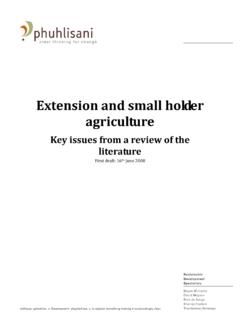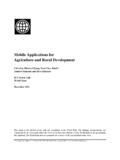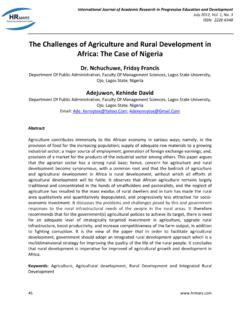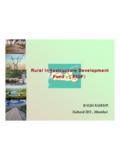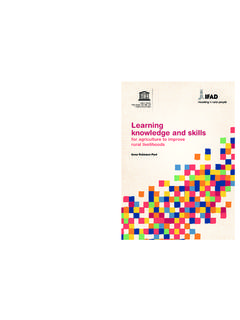Transcription of International and local approaches to rural …
1 International and local approaches to rural development Key issues and questions: A review of the literature for the Drakenstein Municipality Phuhlisani Solutions: September 2009 Phuhlisani Solutions: September 2009 1 y International and local approaches to rural development Key issues and questions: A review of the literature for the Drakenstein Municipality Contents CONTENTS .. 1 BACKGROUND .. 3 THE STRUCTURE OF THE REVIEW .. 3 CONTESTED GLOBAL development PARADIGMS .. 3 MODERNISATION THEORY .. 4 Marxist development theory.
2 5 More similarities than differences .. 5 Globalisation .. 6 The sustainable development imperative .. 6 SUMMARISING THE PARADIGM SHIFTS .. 8 LOCATING rural development IN WIDER development DISCOURSE .. 8 DEFINING rural development .. 9 EVOLVING IDEAS AND approaches TO rural development INTERNATIONALLY .. 9 1950 s .. 10 1960 s .. 10 1970 s .. 11 1980 s .. 12 1990 s .. 13 2000 s .. 14 REFLECTIONS ON THE CHRONOLOGY .. 17 development AND rural AREAS IN SOUTH AFRICA PRE 1994 .. 18 LAND DISPOSSESSION .. 18 TWO AGRICULTURES?.
3 20 HISTORICAL MEASURES TO STRENGTHEN THE WHITE COMMERCIAL FARMING 20 HISTORICAL MEASURES TO REGULATE PRODUCTION AND LAND USE IN THE RESERVES AND THE HOMELANDS .. 20 THE HOMELAND ERA .. 21 DBSA farmer support 21 rural development IN SOUTH AFRICA POST 1994 .. 22 REVISITING ASSUMPTIONS ON rural URBAN LINKAGES .. 23 THE rural development STRATEGY OF THE GOVERNMENT OF NATIONAL UNITY .. 24 rural development FRAMEWORK (1997) .. 25 THE INTEGRATED SUSTAINABLE rural development STRATEGY (2000).. 26 LINKING LAND REFORM, AGRICULTURE AND rural development .
4 29 Phuhlisani Solutions: September 2009 2 y TIPS .. 29 Settlement and Implementation Support Strategy for Land and Agrarian Reform .. 30 Guidelines for Delivering Effective Settlement and Implementation Support for Land Reform in the Western Cape .. 33 NEW AGRICULTURAL POLICY .. 34 Rethinking the two agricultures thesis .. 34 The need for a more nuanced understanding of agriculture and rural livelihoods .. 36 Retraining extension staff .. 36 Assessing extension effectiveness .. 38 Developing an appropriate extension approach.
5 38 The state of the extension service .. 39 Extension staff employed per province .. 39 Extension support to land reform .. 39 THE SECOND ECONOMY STRATEGY .. 40 THE COMPREHENSIVE rural development PROGRAMME .. 41 OVERARCHING QUESTIONS .. 44 CONCLUSION .. 45 REFERENCES .. 46 Phuhlisani Solutions: September 2009 3 y Background The newly elected South African government has adopted a renewed and focused attempt to facilitate and promote rural development which all spheres of government are required to understand and orientate their programmes to correlate with this focus.
6 The Drakenstein Municipality has responded to this call and has developed a draft rural development Strategy with an associated implementation programme. To enable reflection on the strategy development process and the priorities it has identified, the Municipality has commissioned a comprehensive literature review on issues of rural development . The structure of the review This literature review is anchored by five questions: How has thinking about development changed over time? What can we learn from the different approaches that characterise the International experience of rural development ?
7 What can we learn from how South Africa has approached rural development pre and post 1994? What are the key livelihood and employment opportunities for the rural poor? What are the key issues of relevance to the Drakenstein Municipality? To address these questions we: Sketch changing global development paradigms; Map changing approaches and thinking about rural development priorities internationally; Review key issues and concepts associated with rural development theory and practice; Provide a critical history of rural development initiatives in South Africa; Identify the principle components of strategies designed to make rural development happen.
8 Examine the fit between the key findings of the literature and the priorities of Drakenstein Municipality as expressed through its IDP and draft rural development Strategy document. Contested global development paradigms As we will examine the concept of development is not neutral but continues to be fundamentally contested. The primary purpose of the development text (like most others) is to convince, to persuade, that this (and not that) is the way the world actually is and ought to be amended. But ideas about development do not arise in an institutional or literary vacuum.
9 They are rather assembled within a vast hierarchical apparatus of knowledge production and consumption sometimes known development industry . This industry is itself implicated in the operation of networks and of power and domination that in the Twentieth Century have come to encompass the entire globe. (Crush, 1995: 5) The concept of development gained particular prominence in the period following World War 2. Gustavo Esteva dates the appearance of the new development era to 2oth January 1949 when President Harry Truman took office as the post war US President and promised a bold new for the improvement and growth of underdeveloped areas.
10 (Esteva, 1993: 6) This formalised a distinction between Phuhlisani Solutions: September 2009 4 y developed countries and other poor countries primarily in the South which were deemed to be underdeveloped . Historically the discipline of development studies, in which rural development plays a key part, combines two elements: how to promote economic growth, and how to overcome poverty in the global South. (Bernstein, 2005) The underlying assumption in Truman s speech, and of the development policies and programmes which followed, was that the impoverished nations of the South should seek to emulate the industrial growth path of the North.
